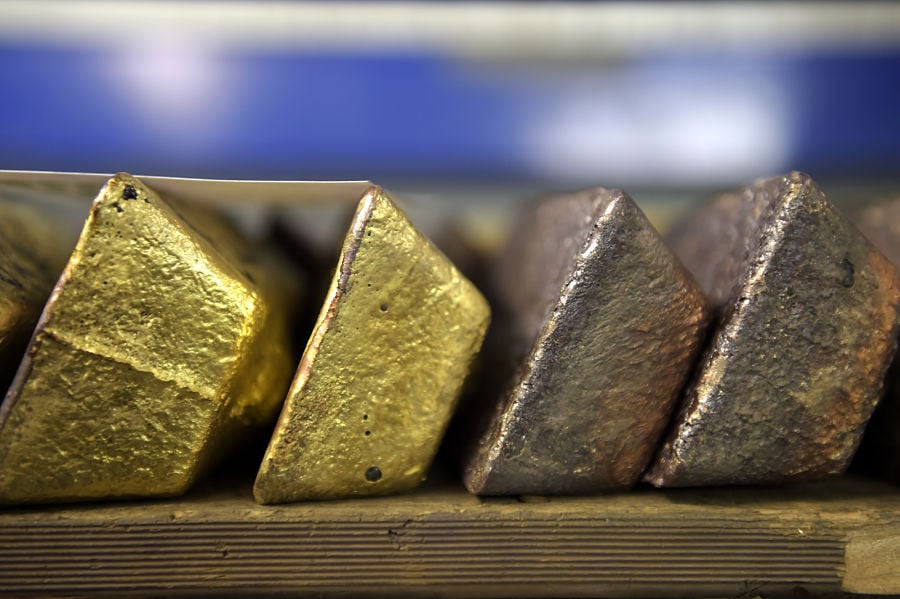

With uncertainty overshadowing the economy and financial markets, debates over whether gold serves as an effective hedge are cropping up again.
The price of the precious metal, as tracked by the $57 billion SPDR Gold Shares ETF (GLD), has risen 5.7% since the start of the year, which is nearly on pace with the 6% gain by the S&P 500 Index.
But true believers and recent converts are likely looking back about a month to gold’s less correlated 0.77% decline for 2022, which compared to the 18.2% drop in the S&P 500.
“Gold has a 0.1 correlation to U.S. large-cap stocks, which is actually less than bonds and most other asset classes, so it can be a smart hedge,” said Kyle Simmons, lead financial planner at Simmons Investment Management.
“Some people get oversold on gold as an investment, so I am careful when talking to clients to make sure it doesn’t represent too much of their overall net worth,” Simmons added.
Gold naysayers, who tend to describe it in such terms as a non-dividend-paying rock that sometimes goes up and sometimes goes down, are typically against allocating to gold as a long-term portfolio hedge.
Currently priced at around $1,932 an ounce, gold is hovering near its recent peaks of $1,951 in March 2022 and $1,923 in September 2020. But between those peaks, the price dropped by 14.6% to $1,666 in October 2022, and by 10.5% to $1,721 in March 2021.
It’s that kind of price pattern that has some advisors justifying only short-term allocations.
“Gold rallied in 2022 before falling to a 2022 low, then rallied into year-end; that’s not a hedge,” said Paul Schatz, president of Heritage Capital.
However, he said, “I do think gold launched a new bull market in the fourth quarter of 2022 and will see at least $2,000 this year, with a chance to push well into new highs.”
Schatz believes the current gold price run is fueled by a weakening U.S. dollar and an anticipated change in the Federal Reserve’s monetary policy.
“I would buy gold and silver into any and all weakness,” he said.
Karen Ogden, partner at Envest Asset Management, isn't big on jumping in and out of gold, and believes location is more important than allocation.
“I like keeping an allocation to gold even though some question its strength as an inflation hedge,” Ogden said. “A key thing about gold that many miss is the location of where the investment is held is as important as the allocation.
"Many investible forms of gold are taxed at a collectible 28% tax rate," she said. "Investors that hold it in a taxable account may mistakenly believe that any gains from positions held for more than a year will be taxed as long-term capital gains, but investments in popular ETFs like IAU and GLD are actually taxed at the 28% collectible rate. If you are also subject to the net investment income tax of 3.8%, your gains in gold may be taxed at 31.8%.”
Learn How is tax on gold calculated here.
Meanwhile, some advisors see gold as a core, all-weather allocation that's not to be messed with.
“Both gold and silver should be part of clients' portfolios in this environment, and I have been holding both for my clients in the last 12 to 15 months,” said Hans-Christian Winkler, founder of Winkler Wealth.
“I do not consider gold or silver a hedge but an important allocation during certain market and economic environments as we are having right now,” he added. “To go a step further, I think this environment also warrants to hold both gold and silver producers in certain clients' accounts as there is a big discrepancy between gold and silver spot prices and where producer shares are trading right now.”
Dennis Nolte, vice president of Seacoast Investment Services, said gold is the right asset class for the times.
“We have been allocating to gold in our discretionary accounts in anticipation of an economic slowdown and recession,” he said. “Gold does not trade like a commodity but rather a currency and tends to do well in falling interest-rate environments. We see that scenario playing out later this year.”

Executives from LPL Financial, Cresset Partners hired for key roles.

Geopolitical tension has been managed well by the markets.

December cut is still a possiblity.

Canada, China among nations to react to president-elect's comments.

For several years, Leech allegedly favored some clients in trade allocations, at the cost of others, amounting to $600 million, according to the Department of Justice.
Streamline your outreach with Aidentified's AI-driven solutions
This season’s market volatility: Positioning for rate relief, income growth and the AI rebound
